Speed bento technique: making & freezing yaki onigiri, onigiri
This is another speed bento made with previously frozen yaki onigiri (grilled rice balls) that I defrosted/warmed in the microwave for good texture). The yaki onigiri worked out surprisingly well — I don’t usually have fresh rice hanging around the house, so this’ll be another time saver on mornings when I suddenly feel like rice. The homemade ma po tofu, store-bought Korean octopus panchan, steamed kabocha and juice jello cup were all leftovers, so it only took about 5 minutes to assemble this bento in the morning.
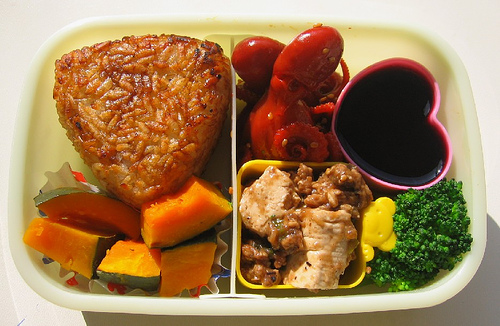
Yaki onigiri freeze extremely well, retaining their shape and flavor when packed in bento lunches and eaten at room temperature (important: reheat in the microwave before packing). Yaki onigiri are classic izakaya (pub) or bento food — very nostalgic for us. I’m lucky my husband didn’t eat all of them when I was making them!
First I made rice balls with triangular onigiri molds, then lightly firmed them up with my salted, wet hands for a flavor boost. Using molds is optional, of course — you could form them freehand if you like. In Japan, I usually saw yaki onigiri without stuffing or nori wrapping, but make them however you like best. You can grill them on an indoor fish grill (shown here), a grilling rack placed directly on a gas burner, an outside gas or charcoal grill, inside grill pan, etc. (EDIT: you can also make them over low heat in a nonstick frying pan lightly oiled with vegetable oil.) First heat the grill to medium heat, place the onigiri on the grill, and don’t move them at all for several minutes. Gently turn it over once the bottom is lightly browned as shown here. Grill the bottom half until browned, then turn down the heat to low.
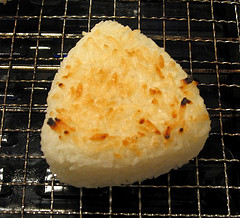
With the heat now reduced to low, lightly brush the browned top with soy sauce and turn it over so that it heats through. Brush the other browned side with soy sauce, and turn it over again so that both sides have been grilled twice: once plain, and once with soy sauce. If you like, you can also brush the sides with soy sauce and grill those as well. The onigiri should now have a crisp outside crust.
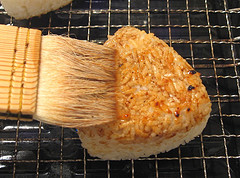
It’s now ready to eat, pack in your lunch, or freeze. To freeze, first wrap each individual onigiri in plastic wrap, freeze, then put them all in a freezer bag for longer-term storage (sucking the air out of the bag with a straw — think of do-it-yourself FoodSaver vacuum-packing). To use a frozen yaki onigiri, it’s important to reheat it first in the microwave before packing (on Cook until it’s warm), otherwise the texture of the soft rice inside will be nasty. The crunchy exterior softens in the freezing/reheating, but otherwise tastes the same as when it’s fresh.
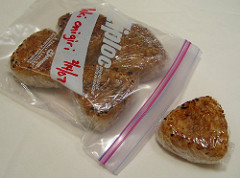
My son had a similar bento today, but with pre-frozen onigiri rolled in sakura denbu (sweet, colored fish flakes) and red hana ebi (savory, colored fish powder).
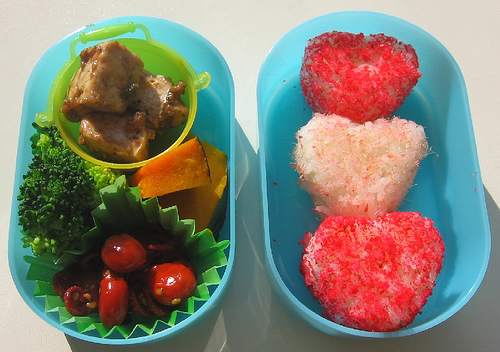
Surprisingly, you can actually prepare onigiri in advance and stash them in the freezer. No, seriously, you can — it’s in Japanese-language bento books and I saw people do it when I lived in Japan. The trick is to use very fresh rice (that’s moist and hasn’t been sitting in the rice cooker for hours), wrap each onigiri individually before freezing, and after you take them out of the freezer be sure to heat them in the microwave until they’re warm and soft again. If you thaw them on the counter or in the refrigerator the texture will be hard and nasty, so the microwave step is very important. (EDIT: If you’re concerned about microwaving food wrapped with plastic wrap, unwrap the frozen rice, place it in a bowl, then cover the bowl with a lid, microwave-safe cover or plastic wrap that doesn’t touch the surface of the food. Then microwave until warm.)
In this photo I put all of the freshly wrapped, warm onigiri (shaped in molds) on a metal pie plate to speed freezing.
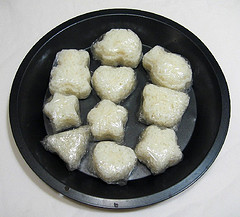
After freezing, I put them in a labelled freezer bag and sucked all of the air out of the bag with a straw before sealing (like do-it-yourself FoodSaver vacuum packing). This helps ward off freezer burn.
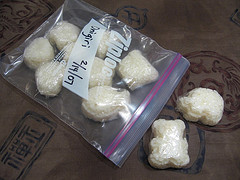
READ MORE:
- Need for speed: A mommy’s lunch manifesto
- Food safety for packed lunches
- How to pack a bento lunch and use “gap fillers“
- Choosing the right size bento box
- Biggie’s list of top speed tips, tutorials and equipment reviews
- Subscribe to Lunch in a Box by e-mail updates or via RSS feed





